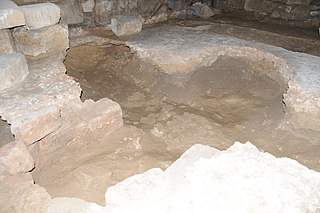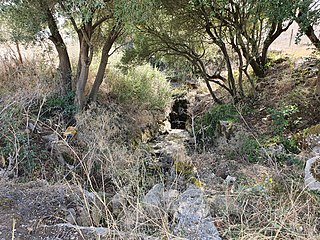Related Research Articles

The Roman ruins of Villa Cardillio is an archaeological site located in central Portugal. Situated in the rural civil parish of Santa Maria, it is located approximately 3 km from the centre of the municipal seat of Torres Novas. Receiving its name from a mosaic pavement onsite, the specific translation of piece is still unclear, but assumed that the site was owned by a couple. The ruins were first excavated in 1962, yielding hundreds of coins and well as ceramics, bronze works, Assyrian and Egyptian glass works. Also revealed were some jewellery and a statue of Eros.

The Monastery of Dumio, is a former paleo-Christian monastery in the civil parish of Dume, municipality of Braga, in northwestern Portugal. Originally a Roman villa, it was the base of a basilica by Suebi tribes, and later Christian monastery headed by Martin of Braga in the 6th century. The re-discovery of the Roman ruins in the late 20th century resulted in archaeological excavations that unearthed its former use.

The Roman Ruins of Cerro da Vila are the remnants of a historical villa in the Algarve region of southern Portugal. Its vestiges lie in the vicinity of the resort and marina of Vilamoura, in the civil parish of Quarteira, municipality of Loulé Municipality.

The Tower of Pedro-Sem is a medieval fortification situated in the civil parish of Lordelo do Ouro e Massarelos, that protected the northern Portuguese city of Porto.

The Fountain of Passeio Alegre is a fountain located in civil parish of Aldoar, Foz do Douro e Nevogilde, municipality of Porto in northern Portugal.
The Roman villa of Vale do Mouro is a Roman settlement situated in the civil parish in the municipality of Meda, excavated since the early 21st century by archaeologists.

The Castle of Alfeizerão is a Portuguese medieval castle in civil parish of Alfeizerão, municipality of Alcobaça, and in the Oeste region of the historical Estremadura province.

The Roman ruins of Santo Andre de Almoçageme is a Portuguese archaeological site located in the rural civil parish of Colares, in the municipality of Sintra. It includes a group of structures with typological, stylistic or historic value, whose structural elements are worthy of preservation.

The Roman Dam of Belas is a 3rd-century Roman barrier constructed to serve the city of Olisipo, located in civil parish of Queluz e Belas, municipality of Sintra.

The archaeological site of Colaride, is a Roman necropolis in a natural cave, located in the Portuguese civil parish of Agualva e Mira-Sintra, municipality of Sintra.

The Roman ruins of Casais Velhos are the remains of a Roman town, in the municipality of Cascais, Lisbon District, Portugal that included baths, two cemeteries, remains of a wall and ceramic artifacts.

The Roman villa of Alto da Cidreira is a Roman villa in the civil parish of Alcabideche, municipality of Cascais, in the Lisbon District of Portugal. Although known since the 1890s, this site has largely been neglected by archaeologists, resulting in destruction of artefacts, including Roman era mosaics, a bath complex and an olive oil cellar.
The Roman villa of Outeiro de Polima is a Roman villa in the civil parish of São Domingos de Rana, in the Portuguese municipality of Cascais, dating from the 1st to 6th centuries AD.

The Roman Villa of Frielas is located in the parish of Frielas in the municipality of Loures in the Lisbon District of Portugal. It fell under the territory of the Roman settlement of Olisipo, which covered a large area from Lisbon to the south to Torres Vedras in the north. It is believed to have been re-used in the medieval period during the Islamic occupation of Portugal. Excavations began in 1997 and are continuing, over an area of about 3500 square metres. Since 2012 the villa has been classified as a Site of Public Interest.

The Roman Thermae of Maximinus, are the archaeological ruins of a monumental building and public baths, whose construction was integrated into the urban renewal of the civitas of Bracara Augusta, the Roman provincial capital of Gallaecia. The large public/civic construction consisted of a building, housing the baths and a theatre, although the archaeological excavations continue.

The Archaeological site of Cabeço do Vouga, also known as Castelium Marnelis, is an archaeological site in civil parish union of Trofa, Segadães e Lamas do Vouga, in the municipality of Águeda, in central Portugal. It is classified as a Property of Public Interest, and dates back to the Iron Age.
The Arcaheological site of Quinta dos Patudos is an archaeological site in the civil parish of Alpiarça, in the municipality of the same name in the Portuguese district of Santarém. Sometimes referred to as the "castle" of Alpiarça, it is part of an archeological station within the Quinta dos Patudos, that includes the Castle of Alpiarça, Cabeço da Bruxinha, Necropolis of Tanchoal and the Necropolis of Meijão.
The Castle of São Ramão is a medieval castle located in the civil parish of Viade de Baixo e Fervidelas, in the municipality of Montalegre, Portuguese district of Vila Real.

The Roman villa of Freiria is a Roman villa in the civil parish of São Domingos de Rana, in the Portuguese municipality of Cascais.

The Fort Nossa Senhora da Luz, also known locally as Castle of Senhora da Luz is a fort in the civil parish of Luz, municipality of Lagos in the Portuguese Algarve, classified as a Property of Public Interest.
References
Notes
- ↑ Becker, J. (2009-04-17). "Places: 360881593 (Quinta da Bolacha)". Pleiades. Retrieved 3 May 2014.
- ↑ "Villa Romana da Quinta da Bolacha - Estações Arqueológicas - Amadora -". www.lifecooler.com. Archived from the original on 2009-09-16.
- 1 2 3 4 5 6 7 8 9 10 Martins, A. (2015), Villa Romana da Quinta da Bolacha, IGESPAR – Instituto de Gestão do Património Arquitectónico e Arqueológico (Portuguese Institute of Architectural and Archaeological Heritage), retrieved 5 March 2016
- 1 2 3 4 5 6 Figueiredo 2012, Paula, SIPA (ed.), Citânia de Briteiros (IPA.00033950/ PT031115050042) (in Portuguese), Lisbon, Portugal: SIPA – Sistema de Informação para o Património Arquitectónico, retrieved 5 March 2016
{{citation}}: CS1 maint: numeric names: authors list (link) - ↑ Jorge Augusto Miranda, Gisela Encarnaçã and Eduardo Rocha (1999), p. 64
- ↑ G. Incarnação (2003)
Sources
- Raposo, Jorge (2001), 300 Sítios arqueológicos visitáveis em Portugal, Al-madan (in Portuguese), Almada, Portugal
{{citation}}: CS1 maint: location missing publisher (link) - V.V. A.A. (1997), Sentir o Romano. Vestígios Materiais (in Portuguese), Amadora, Portugal
{{citation}}: CS1 maint: location missing publisher (link) - Miranda, Jorge Augusto; Encarnação, Gisela; Rocha, Eduardo (1999), Do Paleolítico ao Romano, Amadora, Portugal
{{citation}}: CS1 maint: location missing publisher (link) - Encarnação, Gisela (2003), A Villa romana da Quinta da Bolacha. Um caso de arqueologia urbana", Actas do Quarto Encontro de Arqueologia Urbana (in Portuguese), Amadora, Portugal
{{citation}}: CS1 maint: location missing publisher (link)